
In evolutionary biology, adaptive radiation is a process in which organisms diversify rapidly from an ancestral species into a multitude of new forms, particularly when a change in the environment makes new resources available, alters biotic interactions or opens new environmental niches. Starting with a single ancestor, this process results in the speciation and phenotypic adaptation of an array of species exhibiting different morphological and physiological traits. The prototypical example of adaptive radiation is finch speciation on the Galapagos, but examples are known from around the world.

Biogeography is the study of the distribution of species and ecosystems in geographic space and through geological time. Organisms and biological communities often vary in a regular fashion along geographic gradients of latitude, elevation, isolation and habitat area. Phytogeography is the branch of biogeography that studies the distribution of plants. Zoogeography is the branch that studies distribution of animals. Mycogeography is the branch that studies distribution of fungi, such as mushrooms.

Gekkonidae is the largest family of geckos, containing over 950 described species in 64 genera. The Gekkonidae contain many of the most widespread gecko species, including house geckos (Hemidactylus), the tokay gecko (Gekko), day geckos (Phelsuma), the mourning gecko (Lepidodactylus), and dtellas (Gehyra). Gekkonid geckos occur globally and are particularly diverse in tropical areas.

Agamidae is a family of over 550 species of iguanian lizards indigenous to Africa, Asia, Australia, and a few in Southern Europe. Many species are commonly called dragons or dragon lizards.

Anolis is a genus of anoles, iguanian lizards in the family Dactyloidae, native to the Americas. With more than 425 species, it represents the world's most species-rich amniote tetrapod genus, although many of these have been proposed to be moved to other genera, in which case only about 45 Anolis species remain. Previously, it was classified under the family Polychrotidae that contained all the anoles, as well as Polychrus, but recent studies place it in the Dactyloidae.
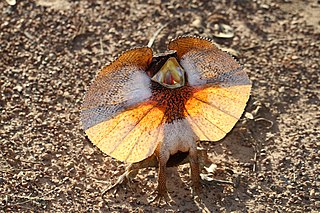
The frilled lizard, also known as the frillneck lizard, frill-necked lizard or frilled dragon, is a species of lizard in the family Agamidae. It is native to northern Australia and southern New Guinea. This species is the only member of the genus Chlamydosaurus. Its common names come from the large frill around its neck, which usually stays folded against the lizard's body. It reaches 90 cm (35 in) from head to tail and can weigh 600 g (1.3 lb). Males are larger and more robust than females. The lizard's body is generally grey, brown, orangish-brown, or black in colour. The frills have red, orange, yellow, or white colours.

The common side-blotched lizard is a species of side-blotched lizard in the family Phrynosomatidae. The species is native to dry regions of the western United States and northern Mexico. It is notable for having a unique form of polymorphism wherein each of the three different male morphs utilizes a different strategy in acquiring mates. The three morphs compete against each other following a pattern of rock paper scissors, where one morph has advantages over another but is outcompeted by the third.

Island gigantism, or insular gigantism, is a biological phenomenon in which the size of an animal species isolated on an island increases dramatically in comparison to its mainland relatives. Island gigantism is one aspect of the more general "island effect" or "Foster's rule", which posits that when mainland animals colonize islands, small species tend to evolve larger bodies, and large species tend to evolve smaller bodies. This is itself one aspect of the more general phenomenon of island syndrome which describes the differences in morphology, ecology, physiology and behaviour of insular species compared to their continental counterparts. Following the arrival of humans and associated introduced predators, many giant as well as other island endemics have become extinct. A similar size increase, as well as increased woodiness, has been observed in some insular plants such as the Mapou tree in Mauritius which is also known as the "Mauritian baobab" although it is member of the grape family (Vitaceae).
The Jiufotang Formation is an Early Cretaceous geological formation in Chaoyang, Liaoning which has yielded fossils of feathered dinosaurs, primitive birds, pterosaurs, and other organisms. It is a member of the Jehol group. The exact age of the Jiufotang has been debated for years, with estimates ranging from the Late Jurassic to the Early Cretaceous. New uranium-lead dates reveal the formation is deposited in the Aptian stage of the Early Cretaceous. Fossils of Microraptor and Jeholornis are from the Jiufotang.

Diprotodontidae is an extinct family of large herbivorous marsupials, endemic to Australia and New Guinea during the Oligocene through Pleistocene periods from 28.4 million to 40,000 years ago.
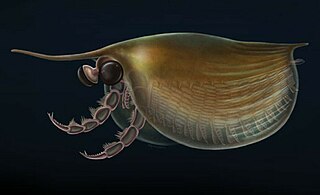
Isoxys is a genus of extinct bivalved Cambrian arthropod; the various species of which are thought to have been freely swimming predators. It had a pair of large spherical eyes, and two large frontal appendages used to grasp prey.
Ecomorphology or ecological morphology is the study of the relationship between the ecological role of an individual and its morphological adaptations. The term "morphological" here is in the anatomical context. Both the morphology and ecology exhibited by an organism are directly or indirectly influenced by their environment, and ecomorphology aims to identify the differences. Current research places emphasis on linking morphology and ecological niche by measuring the performance of traits associated behaviours, and fitness outcomes of the relationships.
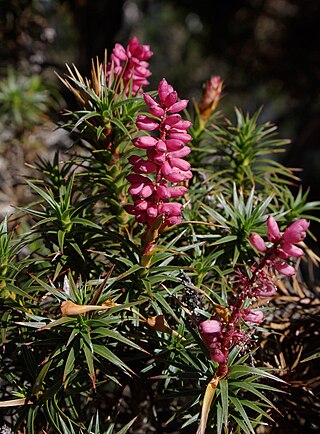
Richea scoparia is a species of plant endemic to Tasmania. The genus Richea, forms part of the Ericaceae family, which are commonly heath-like shrubs. The name refers to the erect bushy growth habit, described as a broom-like shrub, most commonly referred to as the honey bush or simply scoparia to many bushwalkers.

The Carphodactylidae, informally known as the southern padless geckos, are a family of geckos, lizards in the infraorder Gekkota. The family consists of 32 described species in 7 genera, all of which are endemic to Australia. They belong to the superfamily Pygopodoidea, an ancient group of east Gondwanan geckos now only found in Australasia. Despite their well-developed limbs, molecular phylogenies have demonstrated that Carphodactylidae is the sister group to Pygopodidae, a highly specialized family of legless lizards.
Jonathan B. Losos is an American evolutionary biologist and Herpetologist.
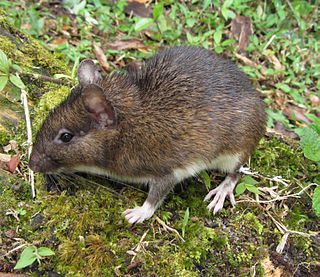
Euryzygomatinae is a subfamily of rodents, proposed in 2017, and containing three extant genera of spiny Echimyidae: Clyomys, Euryzygomatomys, and Trinomys.
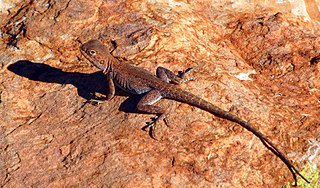
Ctenophorus caudicinctus, commonly known as the ring-tailed dragon or ring-tailed bicycle-dragon is a native species of agamid lizard occurring in rocky ranges and outcrops of Australia. Ctenophorus caudicinctus is most commonly found in the Pilbara region and offshore islands of Western Australia. The ctenophorus has 28 known species in the northern, southern, and western parts of Australia. It is recognized to be the most speciose group of Australian agamids.
Joel Lester Cracraft, is an American paleontologist and ornithologist. He received a PhD in 1969 from Columbia University.
Lynette Gai Cook is an Australian botanist and entomologist. She earned a PhD from the ANU in 2001 with a thesis entitled The biology, evolution and systematics of the Gall-inducing scale insect Apiomorpha Rübsaamen

Phylogenetic signal is an evolutionary and ecological term, that describes the tendency or the pattern of related biological species to resemble each other more than any other species that is randomly picked from the same phylogenetic tree.














